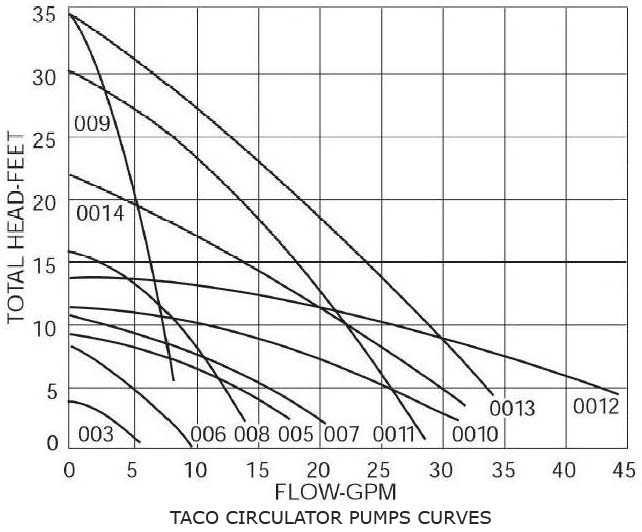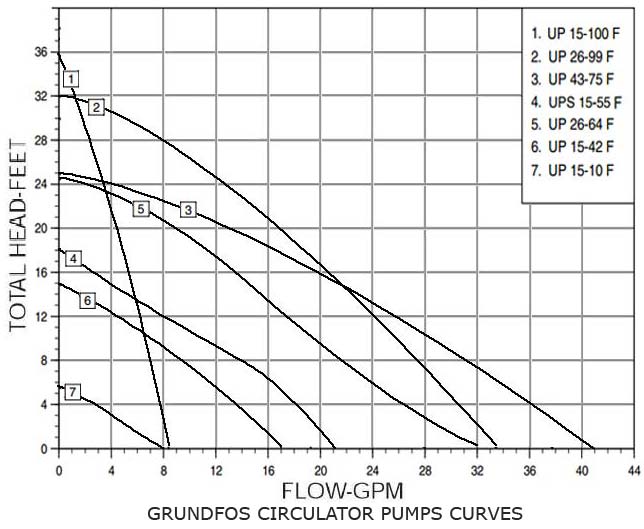Each Circulator Pump has several important features, that have to taken into consideration prior to making a purchase.
These features include the material of construction (cast iron, bronze, stainless steel), flow rate (GPM, or Gallons per Minute), head loss (in ft of head), horsepower (HP), power supply (V) and connection type/size (flanged, threaded, sweat).
Most common type of circulator pumps used for closed loop radiant or hydronic heating applications are cast iron flanged circulators.
Stainless Steel and Bronze circulators are typical for open loop hydronic/radiant heating and domestic hot water recirculation applications. Threaded and sweat connection types are particularly common for the later application type, making it easier to connect the circulator in line with an existing water line.
Examples of Circulator Pumps with different connections:
By default, all Taco circulators and Grundfos circulators are 115 Volts, 60Hz. All other models, such as with 230V power supply or with an outlet plug are usually custom ordered.
Head loss is associated with friction of the water against the internal surface of the pipes/tubing in the hydronic or radiant heating system and restricts flow rate a circulator can produce.
Although radiant heat manifold and PEX tubing sizing are a different topic, let's assume, for example, that a manifold has 8 outlets with 1/2" PEX tubing installed at 300ft length per loop and the system calls for 72,000 BTU's.
Using the formula above, we can determine the flow rate required for our given zone: 72,000/10,000 = 7.2 GPM.
Flow rate through every selected circuit of the manifold equals Flow Rate divided by number of Circuits:
7.2 GPM/8 circuits = 0.9 GPM per circuit (assuming that the circuits are equally balanced).
Using a Pressre Drop Table or Pressure Drop Chart, supplied by the PEX tubing manufacturer, a pressure drop per ft of tubing can be calculated at a given GPM flow rate.
NOTE: Pressure drop data supplied by manufacturers may be available both in PSI (lbs per square inch) and in foot (ft) of head.
For conversion, use the following equation: 1 psi = 2.3 ft of head (for fresh water), and 1 ft of head = 0.43 psi
In this example, pressure drop per 1 ft of 1/2" PEX tubing at 0.9 GPM flow rate would be approximately 0.03 ft of head).
Considering that each individual PEX tubing circuit is 300 ft long, pressure drop per circuit would be 0.03 x 300 = 9.0 ft of head.
Since PEX tubing circuits are in parallel to each other, pressure drop per circuit is always the same as the total zone pressure drop. So, the total pressure drop is: 9.0 ft of head.
We now have the complete specification for the circulator pump available: 7.2 GPM flow at 9.0 ft of head pressure drop.
It is important to understand that other components installed within a given zone (such as the radiant heat manifold itself, fittings, check valves, mixing valves, balancing valves, heat exchangers, PEX tubing length (different diameters), etc.) also have to be considered when sizing a circulator pump (see Scheme 1 below). Pressure drop information is usually available in a form of technical specifications or submittal sheet supplied by the manufacturer.
NOTE: Pump head is a term used to describe the force the circulator develops to overcome pressure drop (pipe, fittings and valves). In a Closed System, "pump head" is NOT the height of the building. Height (#10 on the Scheme above) is not taken into consideration.
Given real conditions, we may add extra 2 ft of head just in case, making pressure drop 11ft of head.


For our example, there are several circulators that fit the description, such as the Taco 008, Taco 009 and Taco 0010.
However, Taco 009 circulator is designed for high head and low flow applications only, meaning that is the flow requirements were to slightly increase, the circulator's performance would fall dramatically.
Similarly is true for the Taco 0010 model. It is designed for use in high flow and low head applications only, so if the pressure drop in the system was to change due to additions or modifications, the pump's performance would drastically decrease.
This leaves us with the Taco 008 circulator, which is the optimal choice for the system under the conditions described.